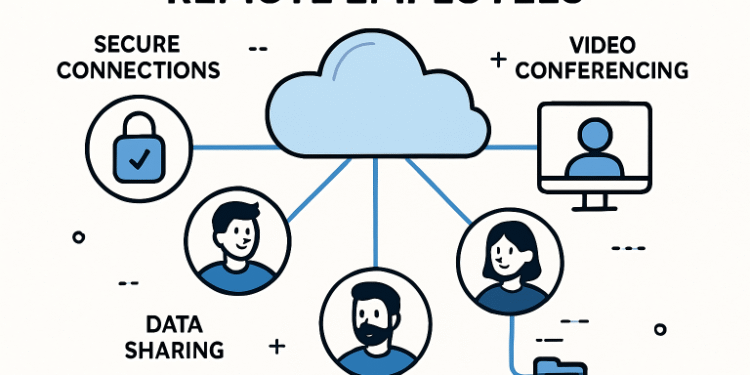Challenges of Remote Work
With the explosive growth of remote work, companies face unprecedented challenges regarding network security, data privacy, and reliable internet connectivity. The home environment exposes business resources to more variables, increasing the risk of connectivity disruptions and cyber threats. Ensuring that remote employees maintain secure, efficient connections to corporate resources is crucial for business continuity. Today’s organizations are turning to advanced networking solutions such as Secure SD-WAN to bridge the distance between remote workers and corporate applications. Secure SD-WAN enables businesses to provide reliable and agile connections, adapting to the variability and unpredictability of home and regional ISPs. A recent survey by Gartner highlights that 80% of businesses identified network reliability as their top concern when expanding remote work capabilities. Besides connectivity, remote work environments often lack standardized security measures. Employees may use personal devices and unsecured Wi-Fi, which increases the risk of data breaches and unauthorized access. This fragmented approach requires IT teams to rethink security and adopt solutions that offer centralized management, policy enforcement, and robust threat prevention. Ensuring that employees and their devices have secure access to necessary business applications means addressing the diversity of home setups and leveraging automation to monitor and troubleshoot issues. The increase in reliance on cloud-based tools and video calling platforms also heightens the need for robust, low-latency network solutions and comprehensive cybersecurity policies.
Software-Defined Networking (SDN)
SDN moves away from the rigidity of traditional hardware-based networks by virtualizing network management and separating the control and data planes. This flexibility allows organizations to adjust bandwidth allocation, apply custom routing rules, and provide efficient access regardless of users’ locations. Centralized orchestration provided by SDN streamlines policy enforcement, automates network configuration, and simplifies scalability. For multi-site and distributed workforces, SDN ensures that data follows optimized routes for better performance and reliability. SDN helps enterprises reduce operational costs and quickly adapt to network changes, making it a key technology for supporting remote operations.
Secure Access Service Edge (SASE)
SASE represents a shift in network architecture, combining SD-WAN, network security functions, and secure internet access into a unified cloud-delivered platform. It introduces an integrated approach by blending zero trust network access (ZTNA), secure web gateway (SWG), firewall-as-a-service (FWaaS), and cloud access security broker (CASB) under a single management console. The key advantage of SASE is that it delivers consistent security and networking policies for users regardless of location or device. Organizations adopting SASE protect data in transit and enforce strong authentication and access policies, reducing risk while promoting performance across remote endpoints. This holistic solution is seeing significant adoption, particularly as hybrid and remote setups become more permanent in the global workforce.
Unified Communications (UC) Systems
Communication silos can impede productivity and morale for distributed teams. Unified Communications (UC) systems address this by integrating voice, video conferencing, instant messaging, and file sharing tools into a cohesive experience. This centralization gives employees simple access to essential collaboration resources, reduces platform fatigue, and improves response times. Leaders in UC platforms, like Microsoft Teams and Zoom, offer seamless integrations with document storage and workflow automation, directly supporting the flexibility remote workers require. The ability to scale these platforms according to business demand makes them critical in digital transformation strategies for remote work.
Edge Computing and Low-Latency Solutions
Edge computing brings data processing closer to the source, minimizing latency and enhancing user experiences for time-sensitive applications like video conferencing, IoT, and virtual desktops. Remote workers benefit from reduced delays and improved access speeds, especially in bandwidth-constrained or geologically distant environments. Businesses can reduce the strain on core data centers and public cloud backbones by leveraging local processing at distributed edge locations. Edge computing is gaining traction as companies prioritize real-time data applications and reliable service delivery.
Collaboration Between Networking and Security Teams
Collaboration between IT networking and cybersecurity teams is vital to protecting sensitive information and building secure, resilient remote environments. Security must be embedded within network design from the outset, as opposed to being a reactive afterthought. This integration results in faster issue resolution, transparent policy development, and more thorough risk management. Proactive cross-team collaboration ensures rapid identification and response to threats, whether they come from compromised home devices or sophisticated phishing campaigns targeting remote employees. Organizations that foster communication between these teams report greater overall risk mitigation and reduced incident response times.
Best Practices for Implementing Networking Solutions
- Assess Current Infrastructure: Start by evaluating your organization’s network capabilities, identifying any performance bottlenecks, security risks, or outdated equipment.
- Adopt Zero-Trust Security: Shift away from legacy perimeter-based defenses and implement a zero-trust approach in which all users, devices, and connections are continuously verified.
- Regular Policy Updates: Schedule routine reviews and updates of your security and access policies to keep pace with evolving threats and evolving business needs.
- Invest in Employee Training: Empower staff through regular training on security awareness and the proper use of remote networking tools, reducing the likelihood of unintentional mistakes.
Conclusion
The transition to remote work is a permanent shift for many organizations. Success now depends on implementing flexible, secure networking solutions tailored to the modern work landscape. By embracing SDN, SASE, UC systems, and edge computing, enterprises can provide their teams with the infrastructure and tools needed to collaborate effectively and securely, no matter where they work.





